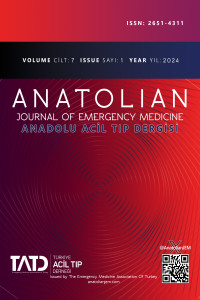Öz
Amaç: Akrep sokmasına bağlı gelişen akrep zehirlenmesi sonucu, yaşamı tehdit eden solunum ve kardiovasküler bulgular yanında inme nadir görülen bir komplikasyondur. Bu olgu sunumunda literatürde nadir sunulan akrep sokmasına sekonder, geçici iskemik atak geçiren bir hastayı sunduk.
Olgu: Olgumuz 69 yaşında erkek hasta sabah uyandığında sol bacağında bir ağrı hissetmiş. Bu ağrıdan yaklaşık 1.5 saat sonra gelişen sol kol ve bacakta güçsüzlük, konuşma bozukluğu gelişmiş. Hastanın yapılan ilk muayenesinde dizarti, fasial asimetri ve sol tarafında güç kaybı tespit edildi. Diffüzyon manyetik rezonans görüntüleme, beyin tomografisi ve beyin tomografik anjiosunda patoloji izlenmedi. Yapılan fizik muayenede hastanın kıyafetleri arasında ölü akrep ve sol ayak bileği düzeyinde hafif derecede kızarıklık ve şişlik izlendi. Hastadaki tüm nörolojik defisitler 3 saat sonra tamamen düzeldi. Yapılan tetkiklerde risk faktörü saptanmaması nedeni ile akrep zehrine bağlı geçici iskemik atak olduğu düşünüldü.
Sonuç: Geçici iskemik atak etyolojisi araştırılırken nörolojik muayene ve anamnezin yanında dikkatli fizik muayene yapılması nadir nedenlerin ayırıcı tanısı açısından çok önemlidir.
Anahtar Kelimeler
Destekleyen Kurum
Sağlık Bilimleri Üniversitesi, Kayseri Şehir Hastanesi
Kaynakça
- Ravi P, Kandan B. Scorpion sting and blindness: A case report. J Family Med Prim Care. 2023 Jan;12(1):171-173
- Reddy C R, Bompelli N, Khardenavis V, Deshpande A. Scorpion bite-induced ischaemic stroke . BMJ Case Rep. 2017 Oct 11;bcr 2017221606.
- Del Brutto OH. Neurological effects of venomous bites and stings: snakes, spiders, and scorpions. Handb Clin Neurol 2013;114:349-68
- Mishra A, Binu A, Abraham G, Vanjare H, George T, Iyadurai R. Cerebrovascular Injury Following Scorpion Sting and Snake Envenomation: A Case Series 2018 Nov;45(6):669-674.
- Karnad DR. Haemodynamic patterns in patients with scorpion envenomation. Heart. 1998 May;79(5):485-9. doi: 10.1136/hrt.79.5.485. Erratum in: Heart 1998 Jun;79(6):631.
- Derkoui A. Ischemic stroke: infrequent complication of scorpion envenomation. Presse Med. 2011 Jan;40(1 Pt 1):106-8.
- Golcuk, Y. Ozsarac M. Bilge A, Golcuk, B, Cinar, B., Hayran, M. "Transient ischemic attack after Mesobuthus gibbosus envenomation". Medical Science and Discovery 2 (2015): 165-66
- Thomas VV, George T, Mishra AK, Mannam P, Ramya I. Lateral medullary syndrome after a scorpion sting. J Family Med Prim Care. 2017 Jan-Mar;6(1):155-157. doi: 10.4103/2249-4863.214988.
- Sigirci A, Öztürk M, Yakinci C. Cerebral atrophy and subdural haemorrhage after cerebellar and cerebral infarcts in an 8-month-old child after having been stung by a scorpion. BMJ Case Rep 2014. 2014 pii: Bcr2014205091
- Udayakumar N, Rajendiran C, Srinivasan AV. Cerebrovascular manifestations in scorpion sting: A case series. Indian J Med Sci.2006;60:241–4
- Jain MK, Indurkar M, Kastwar V, Malviya S. Myocarditis, and multiple cerebral and cerebellar infarction following scorpion sting. J Assoc Physicians India. 2006 Jun;54:491-2.
- Thacker AK, Lal R, Misra M. Scorpion bite and multiple cerebral infarcts. Neurol India. 2002;50:100-2
Öz
Aim: Stroke is a rare complication that occurs in addition to life-threatening respiratory and cardiovascular symptoms as a result of a scorpion sting. In this case, we presented a patient who had a transient ischemic attack that developed due to a scorpion sting, which had not been presented in the literature before.
Case: Our case was a 69-year-old male patient who felt pain in his left leg when he woke up in the morning. Weakness and speech disorder developed in the left arm and leg, developed approximately 1.5 hours after this pain. In the first examination of the patient, dysarthria, facial asymmetry, and loss of strength on the left side were detected. No significant pathology was observed in magnetic resonance imaging, brain computed tomography, and brain computed tomography angiography. In the physical examination, a dead scorpion has been found among the clothes, and mild redness and swelling at the level of the left ankle were observed. All neurological deficits in the patient resolved completely after 3 hours. Since no risk factor was detected in the examinations, it was thought that there was a transient ischemic attack due to scorpion venom.
Conclusion: While investigating the etiology of transient ischemic attack, careful physical examination besides neurological examination and anamnesis is very important for differential diagnosis of rare causes.
Anahtar Kelimeler
Kaynakça
- Ravi P, Kandan B. Scorpion sting and blindness: A case report. J Family Med Prim Care. 2023 Jan;12(1):171-173
- Reddy C R, Bompelli N, Khardenavis V, Deshpande A. Scorpion bite-induced ischaemic stroke . BMJ Case Rep. 2017 Oct 11;bcr 2017221606.
- Del Brutto OH. Neurological effects of venomous bites and stings: snakes, spiders, and scorpions. Handb Clin Neurol 2013;114:349-68
- Mishra A, Binu A, Abraham G, Vanjare H, George T, Iyadurai R. Cerebrovascular Injury Following Scorpion Sting and Snake Envenomation: A Case Series 2018 Nov;45(6):669-674.
- Karnad DR. Haemodynamic patterns in patients with scorpion envenomation. Heart. 1998 May;79(5):485-9. doi: 10.1136/hrt.79.5.485. Erratum in: Heart 1998 Jun;79(6):631.
- Derkoui A. Ischemic stroke: infrequent complication of scorpion envenomation. Presse Med. 2011 Jan;40(1 Pt 1):106-8.
- Golcuk, Y. Ozsarac M. Bilge A, Golcuk, B, Cinar, B., Hayran, M. "Transient ischemic attack after Mesobuthus gibbosus envenomation". Medical Science and Discovery 2 (2015): 165-66
- Thomas VV, George T, Mishra AK, Mannam P, Ramya I. Lateral medullary syndrome after a scorpion sting. J Family Med Prim Care. 2017 Jan-Mar;6(1):155-157. doi: 10.4103/2249-4863.214988.
- Sigirci A, Öztürk M, Yakinci C. Cerebral atrophy and subdural haemorrhage after cerebellar and cerebral infarcts in an 8-month-old child after having been stung by a scorpion. BMJ Case Rep 2014. 2014 pii: Bcr2014205091
- Udayakumar N, Rajendiran C, Srinivasan AV. Cerebrovascular manifestations in scorpion sting: A case series. Indian J Med Sci.2006;60:241–4
- Jain MK, Indurkar M, Kastwar V, Malviya S. Myocarditis, and multiple cerebral and cerebellar infarction following scorpion sting. J Assoc Physicians India. 2006 Jun;54:491-2.
- Thacker AK, Lal R, Misra M. Scorpion bite and multiple cerebral infarcts. Neurol India. 2002;50:100-2
Ayrıntılar
| Birincil Dil | İngilizce |
|---|---|
| Konular | Klinik Tıp Bilimleri |
| Bölüm | Vaka Takdimi |
| Yazarlar | |
| Erken Görünüm Tarihi | 3 Nisan 2024 |
| Yayımlanma Tarihi | 31 Mart 2024 |
| Yayımlandığı Sayı | Yıl 2024 Cilt: 7 Sayı: 1 |

